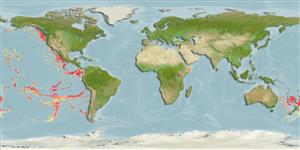Riftia pachyptila Jones, 1981
| Native range | All suitable habitat | Point map | Year 2050 |

|
| This map was computer-generated and has not yet been reviewed. |
| Riftia pachyptila AquaMaps Data sources: GBIF OBIS |
Upload your photos
Google image |
No photo available for this species.No drawings available for Siboglinidae.
Google image |
No photo available for this species.
Classification / Names Common names | Synonyms | CoL | ITIS | WoRMS
Polychaeta | Sabellida | Siboglinidae
Environment: milieu / climate zone / depth range / distribution range Ecology
Sessile; depth range 2564 - 2673 m (Ref. 7675). Tropical
Distribution Countries | FAO areas | Ecosystems | Occurrences | Introductions
Eastern Central Pacific.
Length at first maturity / Size / Weight / Age
Maturity: Lm ? range ? - ? cm Max length : 200 cm TL male/unsexed; (Ref. 99941); max. published weight: 650.00 g (Ref. 99323)
Depth range based on a locality (Ref. 7675); to be replaced with a better reference. The tube length and diameter can measure up to 3 m and 5 m, respectively; but the length of the worm in the 3 m tube is only 1 m (Ref. 99323). Abyssal (Ref. 19). It lacks a functional digestive system and derives its nutrition from vent plumes through an endosymbiotic relationship with chemoautotrophic bacteria stored in a specialized organ called a trophosome (Ref. 99323).
Life cycle and mating behavior Maturity | Reproduction | Spawning | Eggs | Fecundity | Larvae
Spawning is intermittent, not continuous and lasts an hour; release of gametes are propelled upward by withdrawal of the worm into its tube. Neutrally buoyant sperm bundles are expelled forcefully enough to be dispersed over a field of tubeworms; the sperm bundles swim and attach to females, somehow mediating a spawning response in the female; fertilization occurs internally immediately before spawning or externally (within the vestimental chamber?) just after release of the eggs; accumulated eggs are forcefully ejected into the water column where, negatively buoyant, they spend a short period near the site of release; advective conditions of the turbulent, warm-water vent environment disperse gametes and developing larvae away from the adult population.
Main reference
References | Coordinator | Collaborators
Andersen, A.C., S. Hourdez, B. Marie, D. Jollivet, F.H. Lallier and M. Sibuet. 2004. (Ref. 7667)
IUCN Red List Status (Ref. 130435)
CITES status (Ref. 108899)
Not Evaluated
CMS (Ref. 116361)
Not Evaluated
Threat to humans
Human uses
| FishSource |
Tools
More information
Age/Size
Growth
Length-weight
Length-length
Morphology
Larvae
Abundance
Growth
Length-weight
Length-length
Morphology
Larvae
Abundance
Internet sources
BHL | BOLD Systems | CISTI | DiscoverLife | FAO(Publication : search) | Fishipedia | GenBank (genome, nucleotide) | GloBI | Gomexsi | Google Books | Google Scholar | Google | PubMed | Tree of Life | Wikipedia (Go, Search) | Zoological Record
Estimates based on models
Preferred temperature
(Ref. 115969): 1.7 - 2.1, mean 1.8 (based on 76 cells).
Price category
(Ref. 80766):
Unknown.


